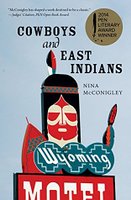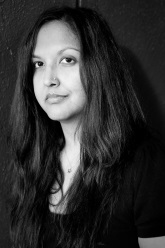Cowboys and East Indians
Nina McConigley
|
|
Nina McConigley grew up a fan of The Little House On The Prairie series by Laura Ingalls Wilder. It was only much later that she realised that Laura and a brown girl like she would never have been friends. “We were the wrong kind of Indians living in Wyoming,” she says in the first line of her debut collection of stories Cowboys and East Indians, published in 2013. Often mistaken for Native American, the Indian characters in these stories struggle to belong in both the American West and in India. Born to an Irish father and Indian mother (from Tamil Nadu,) McConigley speaks readily about her biracial heritage. While her Irish last name typically identifies her, especially on paper, as Caucasian, her Indian looks mark her as an exotic other among the mountains and prairies of Wyoming where she grew up. Again and again in these pages from her book we sense the loneliness of characters who long for acceptance. What the stories say In the title story, originally published in the literary journal Virginia Quarterly Review, the Indian American narrator tries to befriend a group of newly arrived Indian graduate students in the small town of Laramie. She drives them to Wal-Mart to buy things for their apartment. One of McConigley’s strengths is to select details that ring poignantly true. The graduate students buy plastic trashcans, discount shampoo, Corelle plates, a bucket, and a three-dollar pressure cooker. The narrator helps them move mattresses and gives them rides whenever they ask, all the time hoping they will invite her to their home and cook curries for her. In Dot and Feather, Sindu changes her name to Cindy even before she leaves India to go live in the States. Once in Wyoming, she examines the homes of the families of the families she babysits for, fascinated by fake velvet couches and overstuffed recliners, pumpkins on the front porch, tubs of yoghurt and dill pickles in the refrigerator. She lies down on someone’s bed and wonders how it feels to sleep there every night. In the final story, Curating your Life, the 30-year-old narrator Rae who visits India to work as an intern along with two young Americans, says, “I’d thought in the few emails we had exchanged before arriving in India, that I would have the upper hand. That I was the Indian.” Of course, as soon you read these words, you know Rae is in for a surprise. Asking, not answering The book is full of such disarming confessions. Any self-confidence the protagonists feel is shattered by the reactions around them. The resulting uncertainty is the best part of the stories – there are no answers here, only questions. This was evident at a recent talk the author gave at my university on how to represent foreign territories – and people – in fiction. “How do you write the other?” she asked the audience of undergraduate students. “I don’t really know.” The stories in this collection grapple with this question just as the characters grapple with their identities. It is interesting to note that the Irish side of McConigley’s heritage does not seem to feature in her writing very much. When I asked her about that, she said she was raised mostly Indian by her mother. “My father was a geologist and was gone a lot. On the other hand, my maternal uncle and cousins lived with us, and my mom hated Western food. So she would cook Indian all the time and she decorated our house with Indian things. I grew up feeling Indian.” Yet, in the more autobiographical stories, told in first person, the Indian American narrator clearly struggles to authenticate her Indianness. “When people asked if I remembered India, I would always say yes. Yes, of course. And I would lay out my memory like a list.” Even with the rich memories, the photographs, and the best of intentions, the Indian American narrator is painfully aware of the fact that she is unable to blend in, even among Indians. When she walks by a group of Indian immigrants playing cricket, they ignore her. “None of them would make eye contact with me. I tried to smile, even stop and watch, but they all looked away. I looked Indian all right. I even had long black hair. But perhaps it was something in the way that I walked, in my lace-up cowboy boots, in my ranch girl jeans that said, No, she is not.” The first-person stories all seem a touch self-indulgent, with the narrators always ending up feeling sorry for themselves. But that should not take away from their very real sense of isolation. Many outsiders Moreover, it is not only the Indian characters who feel excluded in this collection. In Reserve Champion, Delia has a trophy case full of ribbons from various county and state sewing competitions. “Reserve Champion. Reserve Champion. Reserve Champion…She was never class president, but secretary. Not prom queen, but she had been in charge of the decorations.” Now, all she wants is to show them all by winning the contest held by The National Bank of Wyoming. But standing in her way is the unlikely competitor, the new Indian doctor’s wife, and her exotic sari-clad doll Jasmine. If you pick up the book expecting only to read about Indian Americans or immigrants you will be surprised. Here is a fairly wide range of idiosyncratic characters – the cross-dressing boss, the kleptomaniac babysitter, the medical tourist with terrible skin, the paraplegic wife. In a sense this book is not about Indians at all. It’s about the author’s beloved home state. McConigley is adept at selecting details about India that are not stereotyped, unlike those that some Indian writers in the West are drawn to. Thus, we hear of Enid Blyton books, wealthy Indians dining at five star hotels and driving to Pondicherry to get wine, a melting bar of Cadbury’s Dairy Milk. Still, her best moments come when describes the landscape of Wyoming. She evokes a land, perhaps familiar to many, of dry desert, wide open spaces, snow drifts, prairie dogs and deer carcasses, oil rigs and refineries, and ranch houses, all peopled by gritty, blue-collar men and women who must drink heavy, act tough and “cowboy up. ” Wyoming is the true protagonist of this book. Cowboys and East Indians was the recipient of the 2014 PEN Open Book Award, which is given every year to a writer of color in an effort to promote racial and ethnic diversity within the literary and publishing community. This is from the PEN Judges’ Citation: “Nina McConigley gives us Wyoming precisely the way we expect it – in landscape, sky, and animal life – and in ways we don’t.” What’s Wyoming got to do with it? Often depicted as a land of cowboys in popular culture, Wyoming may have been as much a victim of typed representations as India itself, and the two unlikely cultures collide here. In The White Wedding, my favourite of all the stories, the Indian narrator’s sister returns home to marry a white man in a Western-themed wedding filled with cowboy boots and Stetsons. “Our mountain was small, our town scrappy. It wasn’t the West people were expecting.” This is a book about expectations. The protagonists hope for things they will not get. The visitors expect things they will not find. In the end I am left with this image of a brown girl in Laramie looking in through the windows at the Indian graduate students who party on without her. She is wearing a tank top in the bitter cold, out of place in her own hometown. And yet, this is home, for when she is in India, she sits cross-legged on a bamboo mat on the floor and imagines the Wyoming sky: “So blue. So clear. I pictured nothing but prairie filled with sagebrush, sego lilies, rabbit brush, and endless open. I saw the Big Horns. The Absarokas. The Wind Rivers. The Snowies. I pictured mountain ranges like vertebrae.” Caught between worlds, maybe sometimes you need to write a book to understand where you really belong. Oindrila Mukherjee is a writer and an Assistant Professor at Grand Valley State University in Grand Rapids, Michigan. You can follow her on Twitter at @oinkness.
|


 Nina McConigley
Nina McConigley Interview: Nina McConigley
Interview: Nina McConigley